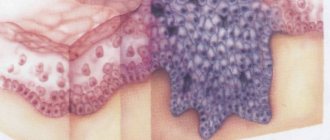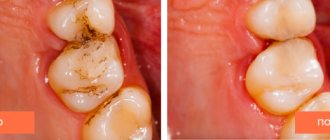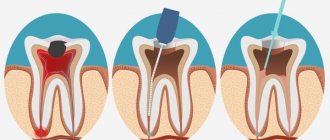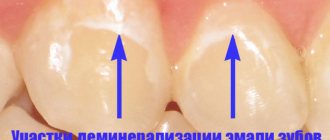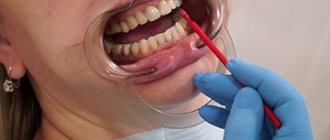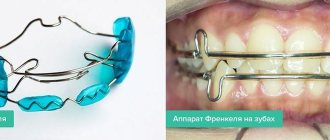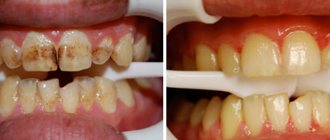Depophoresis is a method of disinfection of damaged internal tooth tissues with copper-calcium hydroxide, which increases the chances of saving complex teeth tenfold. The method is effective for narrow, winding roots. It is also suitable for re-treatment of poorly sealed canals, which cannot be completely unsealed.
Simply put, the procedure destroys pathogenic bacteria in hard-to-reach areas that cannot be treated with conventional instruments during surgical endodontic treatment.
Operating principle
Depophoresis is based on the ability of copper-calcium hydroxide to neutralize pathogenic microflora that has affected the pulp - the neurovascular bundle. Once in the canals, the substance penetrates into the farthest areas and sterilizes them. The process of proteolysis is activated: the “dead” pulp decomposes over time, and the disintegrated tissues are resorbed.
In addition to its disinfectant properties, copper-calcium hydroxide is also believed to stimulate bone formation. It is able to create an alkaline environment in which inflammatory processes cease and conditions for normal bone regeneration are created.
To ensure better passage of the substance through the channels, devices are used that deliver weak current discharges to the tooth. Under the influence of current, copper-calcium hydroxide ions move faster, their trajectory expands, and they spread along the channel.
Errors, complications and doubts...
Despite the use of depophoresis in the Russian Federation since 1990, a number of authors directly point out both the possibility of consequences and complications when using the technique, and the limitations of its capabilities.
Thus, prolonged contact with hydroxides, which slowly dissolve dentin collagen, leads to a weakening of the strength of the dentin of the tooth root. And the movement of ions in an electric field is possible only if there is no intermediate or external cement on the outer surface of the tooth root, otherwise the technique is not justified (the cement substance is a dielectric - an insulator).
The effect of copper, known for its toxicity, deposited in dental tissues on the vital functions of the body has also not been fully studied.
The consequences of using depophoresis also include the possibility of staining of dental tissues, which is especially noticeable on facade - frontal teeth (due to the high copper content in the composition used).
If artificial crowns are not placed on the teeth in the future, the formulation used should be changed to include 10% copper hydroxide, and 90% should be highly dispersed calcium hydroxide.
Scope of application in dentistry
The author of the method, German professor Adolf Knappvost, proposed depophoresis as an alternative to traditional endodontic treatment. According to his research, a positive result from disinfection of canals with copper-calcium hydroxide was observed in 95% of all cases.
However, domestic studies have shown that such high rates cannot be achieved. On the one hand, this difference in research results could be explained by the fact that domestic dentists used other devices instead of the equipment recommended by Knappvost.
On the other hand, living evidence that the method itself is not a universal panacea and does not always work, still speaks for itself. And you can't dispute them.
Yes, this method is undoubtedly effective. But only in combination with classical endodontic measures. For example, the canals are widened with endodontic instruments as far as possible, and then the areas that cannot be penetrated by the instrument are treated with copper-calcium hydroxide.
Indications and contraindications for the procedure
Many dentists use depophoresis in their work. It is usually performed after each depulpation.
But there are a number of other indications.
Depophoresis is recommended in the following situations:
- There is a cyst at the top of the tooth root.
- The channels are crooked and difficult to access, and cannot be cleaned by instrumental means.
- The paths are sealed and the dentist cannot unfill them.
- Remains of gangrenous, dead tissue were revealed in the canal.
When removing the nerve of a tooth, there is a risk of losing a piece of the pulp extractor in the canal. Therefore, dentists offer patients depophoresis. Once the organic compounds are destroyed, the metal piece of the tool is much easier to remove. But even if the fragment is not found, it will not cause any harm to humans after treatment with copper-calcium hydroxide (the element is in a sterile environment, so the risk of infection is zero).
Depophoresis is a safe procedure. But not everyone is allowed to do it.
The following conditions are contraindications:
- pregnancy;
- periodontitis in the acute stage;
- allergy to copper-calcium hydroxide;
- The dental canal is blocked with a silver pin.
Indications
The most important indication is the impossibility of carrying out full endodontic treatment due to too narrow and impassable canals or those whose course is not visible at all. Since it is not possible to “pass” the entire length of the canals with conventional instruments, doctors resort to depophoresis.
Instead of instrumental removal of the affected pulp, it is chemically sterilized with copper-calcium hydroxide.
It is also recommended for patients with previously poorly filled canals in case of re-inflammation of the pulp.
Prescribed for:
- pulpitis;
- chronic periodontitis;
- cyst in the area of the root apex;
- the presence of gangrenous contents and/or dead tissue in the root;
- enlargement of the apical foramen. Nutrients and minerals enter the tooth through this hole.
Not indicated for patients with an allergy to copper, acute periodontitis, or a silver pin in the root. Also not performed on pregnant women.
Tooth affected by pulpitis
IV. First treatment session
Root canal preparation
The root canal is subject to slight expansion (ISO-30) for a maximum of two-thirds of its length, but no closer than 3 mm to the apical foramen. The part of the canal near the crown needs to be expanded a little more to create a depot of copper-calcium hydroxide, as well as to open up possibly undetected parallel canals.
If the channels are poorly passable, the length of the expanded segment can be slightly reduced.
Washing the canal is allowed only with a 10% suspension of “highly dispersed calcium hydroxide” in distilled water.
This suspension can be stored for years in a closed container. The use of tap water or saline is not recommended due to the presence of ions in them, which can significantly weaken the effect of depophoresis.
Filling the root canal with copper-calcium hydroxide
After the tooth is relatively dry, copper-calcium hydroxide is introduced into the canal in one of the following ways:
- On a glass slide with a spatula, stir the paste in distilled water until it reaches the consistency of liquid sour cream. It is introduced into the canal using a canal filler.
- a preparation is instilled into the depot, previously brought to the consistency of liquid sour cream (able to drip) by stirring the original paste in distilled water while rotating at high speeds (paste injection is possible)
- c) the paste, pre-mixed at high speed, is mixed directly in the root canal with a drop of distilled water.
In this case, it is sufficient to fill only the upper 1/3-2/3 of the channel; the remaining volume is filled under the influence of an electric field.
The "working field" must be dry to prevent a significant component of the current from flowing through the gingiva to the anode ("cross current")
In the presence of transverse currents, the actual values of the current value (mA) and the amount of electricity (mA X min) are significantly lower than those shown by the device. To suppress salivation, you can, for example, give an injection of atropine.
During depophoresis, the channel is refilled with a suspension of copper-calcium hydroxide since the heat generated by the passage of current, especially at a current of more than 0.7 milliamps, leads to drying of the channel, which is manifested by a weakening of the current strength. Before refilling the channel, the device must be turned off, then turned on again and, slowly increasing, bring the current to the required value.
Electrode placement
At the doctor's choice (purely for reasons of convenience), a clamp or hook-shaped electrode can be used as a positive electrode (anode).
The clamp electrode (red plug) is placed in the mouth so that the free anodal surface lies on the buccal mucosa. If the oral cavity is dry (for example, after the administration of atropine), the electrode must be pre-moistened with running water.
The hook-shaped electrode must be immersed in the mucous duct of the transitional fold. To prevent metal contact with fillings or crowns when using a hook-shaped electrode, it is necessary to wrap the part in the mouth with gauze moistened with running water.
Negative needle electrode (black plug)
not very deep (3-4 mm) immersed into the root canal in copper-calcium hydroxide with the device turned off. Due to the very high disinfecting power of even traces of copper-calcium hydroxide, there is no need to work with a rubber dam. However, to reduce cross currents, for example in the presence of cavities, a rubber dam may be useful.
Turning on the device for depophoresis “Comfort” or “Original II”
The device is turned on and the current is very slowly increased until the feeling of warmth in the area of the root apex becomes unpleasant for the patient (usually this is noted in the range from 0.5 to 1 milliampere). When an unpleasant sensation appears, it is necessary to slightly reduce the current strength and then increase it again very slowly, stepwise, at intervals of several seconds, to a tolerable value, if possible up to 1 mA or, even better, slightly more.
A stepwise increase in current intensity, to a value far exceeding the patient's initially indicated tolerance limit, is decisive for the effectiveness of depophoresis
Thanks to this, in almost all cases it is possible to significantly increase the level of current tolerated by the patient, sometimes by more than 300%.
To ensure the effectiveness of treatment, the channel must be treated with an amount of electricity equal to at least 15 mA x min. Since such exposure can lead to irritation of the tissues of the apical region, treatment is usually carried out in 3 sessions.
Therefore, during each of the 3 treatment sessions, a minimum of 5 mA X min must pass through the channel.
Example:
- 1 session 1.0 mA X 5.0 min = 5 mA X min
- or 1.5 mA X 3.3 min = 5 mA X min
There is no need to make such calculations during patient treatment, since the “Comfort” or “Original” devices? ? » show not only the current amount of mA, but also the product of mA X min.
Taking into account the possibility of the occurrence of transverse currents, it is recommended for reliability to continue the procedure until 6.0 - 6.5 mA X min is reached.
Foaming fluid released from the root canal as a result of electroosmosis is removed with cotton wool or blotting cloths to minimize cross-currents across the edge of the crown or gingiva towards the anode.
After the end of the treatment session, in order to avoid an unwanted “vitality check”, first of all turn off the device and then remove the needle electrode from the root canal.
Easily accessible, often brown-colored, copper-calcium hydroxide is then removed from the canal. The channel is filled approximately 1/3 with fresh copper-calcium hydroxide without any pressure, as is usually done with any medicine.
The canal is then left open or closed with a temporary filling by making a hole in it.
Rationale:
There is no danger of reinfection deep in the canal due to the fact that, due to its extremely low solubility in water, the copper-calcium hydroxide present in the canal is a saturated solution of the highest disinfecting power.
There are numerous clinical observations indicating that leaving the canal open leads to the prevention of pain after the treatment session.
Important Note:
Proteolysis, on which the dissolution of organic contents and sterilization of all canal systems and, consequently, the entire effect of the method is based, with thoroughly carried out depophoresis, of course, affects small areas of the periapical region around all openings, and not just near one main opening, as happens with instrumental methods. The result is temporary increased sensitivity of the tooth when biting and tapping, or the appearance of a slight pain. Therefore, during the treatment period it is necessary to reduce the load on the tooth as much as possible. After the disappearance of these phenomena, a period of physiological recovery begins. These effects must be distinguished from acute apical periodontitis, which must be treated with established methods.
Devices for depophoresis
The device directs weak current charges to the problem tooth and stimulates the spread of copper-calcium hydroxide through the canal.
Adolf Knappvost exclusively used the Original II, manufactured by Humanchemie. This equipment is the only one approved for working according to the original method of Adolf Knappvost.
However, the alternatives are:
- "EndoEst" is also used for electroodontodiagnostics, electrophoresis, narrowing of the apical foramen, etc.;
- AOK 1.0 Modis – portable device with a graphic indicator;
- AOK 1.1 Endo-lux – equipment for electrophoresis, used as an alternative to Original II Humanchemie;
- AOK 2.1 is a compact device for depophoresis and various physiotherapeutic procedures.
Devices for depophoresis
Description of the procedure
The pulp must first be devitalized, that is, it must stop performing all its functions, including the function of transmitting nerve impulses in response to pain.
Three sessions are required:
- In the first session, the doctor widens the root canal, fills it with copper-calcium hydroxide to a third or two-thirds of its depth and places electrodes in the patient's mouth.
- Then the depophoresis device is turned on, delivering a weak current discharge to the problem tooth. The process ends with the installation of a temporary filling.
- After 8-14 days, at the second session, the procedure is repeated. This is the optimal interval at which the risk of irritation from the application of current is zeroed out.
- At the last third session, the root is filled with atacamite, a special alkaline cement, and the canal is “closed” with a permanent filling.
Nuances of the treatment process
The procedure is minimally invasive, patients do not feel pain. There may only be unpleasant sensations from the application of current.
When working in the frontal area, after each session the oral cavity is thoroughly washed with highly dispersed copper-calcium hydroxide. This is necessary to prevent staining of the enamel.
The result of therapy can be known no earlier than six months later. As a rule, the results are positive and allow you to extend the life of “dead” teeth. After therapy, all patients must be in a dispensary group and regularly observed by a dentist.
Scheme of depopheresis
The method allows you to completely sterilize the root canals of the tooth.
Working with root canals in dentistry is a very responsible procedure. The roots are in a hard-to-reach area, and it is also very difficult to control the treatment process visually. The doctor does almost jewelry work. And if something went wrong, for example, the specialist did not properly clean or disinfect the canals from infection or pulp residues, then in the future, most likely, the tooth will have to be removed.
This is interesting: Dental gumboil: how to quickly remove swelling and swelling, what pills to take?
Depophoresis is a method that doctors use strictly according to indications. Today, in 95% of all cases, it allows one to avoid tooth extraction or root resection, the occurrence of repeated infection in its canals and surgical intervention in the following pathologies:
- the presence of a cyst or granuloma on the root of the tooth,
- complicated caries1,
- the presence of an inflammatory or gangrenous process in the root system,
- work with the dental pulp: removal of the nerve, cleaning the canals from the remains of anesthetized tissue,
- retreatment of previously filled canals,
- indications for preserving the root apex,
- the presence of channels and areas inaccessible to dental instruments,
- dental errors: root perforation, instrument fragments in the canals,
- curved or too wide tooth canals.
Advantages
- Suitable for patients who cannot clean the canals in the traditional way: due to obstruction of the canals, as a result of dentist mistakes;
- sterilization ensures minimal risks of re-infection;
- high percentage of positive results. From 60-70 to 95% according to various studies;
- speed, simplicity and painlessness;
- allows you to avoid resection of the root apex in chronic periodontitis.
Below is a list of dentists that successfully practice complex root canal treatment using depophoresis.
